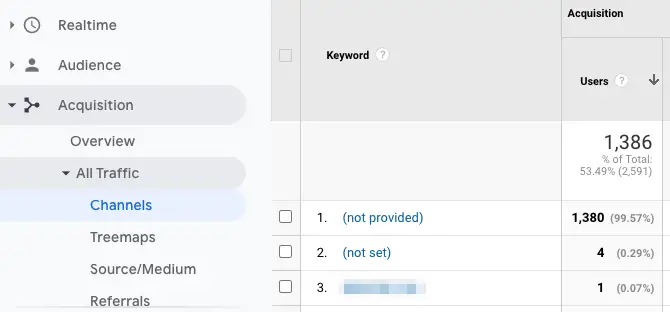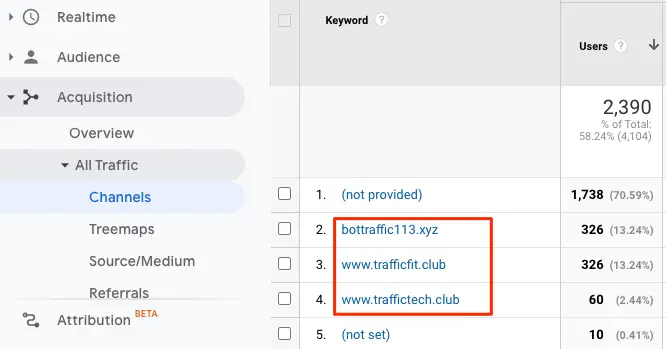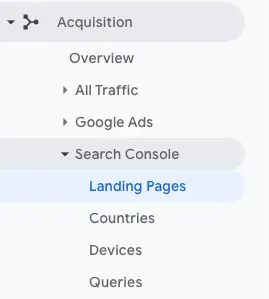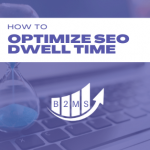Use Google Analytics for SEO Reporting
Most website owners and small- to mid-sized businesses use Google Analytics to monitor their website engagement. The number one thing I noticed as an SEO consultant is that almost none uses Google Analytics reports to their full potential. More, many don’t pay attention to Google Search Console. If they do, they often look at Search Console and Analytics isolated and never connect the dots.
Back to Google Analytics, it can provide deep performance insights into specific pages and sources. In this blog post, I will walk you through an organic traffic analysis in Google Analytics from the SEO consultant’s point of view. We will analyze the most important SEO metrics and discover optimization potentials.
In the first part of the blog post, we will go through the integration of Google Search Console and Analytics. You can also jump ahead to the second part of the most valuable SEO Google Analytics reports.
Google Analytics vs Google Search Console
The two digital marketing platforms Google Analytics and Search Console have one main difference: Google Search Console gathers data of what happens in Google’s search results. Meaning, how many and which pages are indexed and how do they perform in search queries: impressions, clicks, and keyword position.
Google Analytics looks at your website as a whole – not just the Google universe. Anyways, there is one important interface between the two services. What does the engagement look like post Google search result click? Google Analytics can inform us about the page engagement that was driven by Google searches.
Wouldn’t it be nice to know which searches and landing pages perform best in SEO results? A little extreme, but let us assume one keyword ranks on number 1 in the SERPs (Serch Engine Result Page) and drives a lot of traffic. Google Search Console’s reporting ends here. However, we can discover that this page may not result in meaningful business outcomes and people leave after a short time. In contrast, that may hurt the overall site SEO performance in the long run.
(not provided) Keywords in Google Analytics
You probably have seen the annoying (not provided) keyword report in Google Analytics. The organic source acquisition report defaults to the primary keyword dimension. Almost all keywords have the value not provided or not set.
Google Analytics -> Acquisition -> Channels -> Organic Search

Later, we will still use this report for SEO insights and reporting.
One way to work around the not provided keyword problem is to integrate Google Search Console and Google Analytics:
Link Google Search Console to Analytics
Google Analytics has the capability to view Search Console data once the two platforms are linked. Important, you need admin rights for the Google Search Console and Analytics properties you want to link.
There are multiple ways to get to the same result:
1. Google Analytics -> Acquisition -> Search Console -> Any of the available reports (e.g. landing pages) -> Set up Search Console data sharing

If you do this, you will automatically be forwarded to the admin settings. But you can also start there.
2. Google Analytics Admin -> Property -> Property Settings -> Adjust Search Console

Next, add the domain property:

After that: a) Select the GSC property you want to link, and b) link the associate Google Analytics property. Finally, c) Finish the Google Search Console set up and d) hit Save in Google Analytics.
3. Alternatively, you can also link Search Console and Google Analytics through GSC: Settings -> Associations -> Connect a Google Analytics property to this property
Now, you can view Search Console reports in Google Analytics.
Data discrepancies
Please note, there may be some data discrepancies between the Google Search Console data in GSC and Analytics. It can occur that different impressions or click numbers are synced between the two platforms.
6 Most valuable SEO Google Analytics Reports
In the following, I will show you the six most valuable SEO Google Analytics reports for an organic traffic audit. This process works for a pre-audit or during the search engine optimization campaign to identify actions.
Please note, that there are often multiple ways to discover the same information in Google Analytics. I will show you my process.
1. Organic traffic overview
This is one of the most standard SEO reports Google Analytics has to offer. However, there’s so much information in here that you probably don’t look at.
Acquisition -> All Traffic -> Channels
You can gather the following information from this data:
- Overall traffic trends across all acquisition channels over time (I like to look at 6 – 12 months)
- Percentage of organic traffic compared to all channels
- Compare engagement metrics like conversions between the different channels
One thing to take into consideration when comparing Google Analytics data between two channels is the different objectives. Paid Search, for instance, has the goal to convert leads on a landing page, even minimizing the opportunities to view more pages. SEO, in contrast, is most often more high-level content like blog posts and even aims to increase pageviews per session.
2. Organic Traffic Source Breakdown
Secondly, we zoom in on the organic search traffic in the same report. Simply click on “Organic Search”.
Acquisition -> All Traffic -> Channels -> Organic Search
Keywords are the primary default dimension in this report. As discussed earlier the not provided keywords make it hard to use this report. However, it’s essential to identify bot traffic attacks:

Odd noticeable keywords are often the cause of bot attacks. Most times the attacks are temporäry so they are easy to spot due to spikes in the traffic graphs. A flaw of Google Analytics is that you can’t exclude the traffic from standard reports. You will have to manually account for bot traffic.
Additionally, bot attacks may be identified in the referrals, instead of the channels report.
Back to the organic acquisition report, it’s recommended to change the primary dimension (below the graph):
- Source: Which search engine drove the organic visitor. It’s not always Google in SEO!
- Landing Page: On which page land organic visitors first
- Country, region, and city: Which GEOs drive the most organic traffic? This is especially important to local businesses for their SEO strategy – it’s common that search terms can attract a national audience
- User type: New vs returning visitors – it’s crucial to distinguish the behavior and user experience
- Technology like operating systems and browsers are important to understand. WordPress, for example, rolled out the new image formats that are not supported by all browsers. While the new formats help to optimize the page load time, they might cause usability issues for other browsers.
Organic traffic trends are easiest seen in the graph section. Please note, that the prior identified bot attacks are reflected in the following visualization. Nonetheless, I want to see a consistent upward trend in organic traffic.

Note: the red trendline isn’t provided by Google Analytics and was manually added to the screenshot for illustration purposes.
Interpretation: We see a positive organic traffic trend with a spike in April due to the bot attacks. That emphasizes the importance of seeing SEO Google Analytics as a whole instead of separate reports.
3. Search Console Engagement
After linking Google Search Console and Analytics, you can view engagement data based on landing pages, countries, devices, and keywords. Unfortunately, it’s not possible to report on conversion and behavior metrics for keywords in standard reports.

4. Behavior Overview
Even though I already looked at behavioral metrics, I also analyze the behavior report in Google Analytics. However, I don’t use the overview section, but rather look at all pages:
Behavior -> Site Content -> All Pages
I also adjust the segment to only show the top-performing pages for organic traffic: Segment: All users -> Organic Traffic -> Adjust
In the report I pay attention to the following data:
- Percentage of pageviews: I don’t want to heavily rely on only one or two pages that drive organic traffic. If I see a page with more than 40 – 60% I’m too dependent on that page. Service and product businesses often face that problem because their homepage gets most of the attention.
- Bounce and Exit rates: High traffic numbers and high exit/bounce rates indicate a cross-linking optimization opportunity. It’s also good to have a look at the exit pages report.
5. SEO Behavior Flow in Google Analytics
At first glance, the behavior flow seems overwhelming. Nonetheless, the visualization of the user flows how they navigate the page can be very insightful. Still only looking at the organic traffic segment and not all users, we can see which pages have been viewed in what order.
Behavior -> Behavior Flow
I recommend starting with the landing page as the first dimension. Later on, you can also dig deeper into other dimensions like GEOs. It’s also helpful to highlight specific traffic flows by clicking on one individual step.
6. SEO Conversion Reports in Google Analytics
The Reverse Goal Path report applies a similar logic, yet different visualization and starting point. It shows the steps in the reverse order that led to a conversion:
Conversions -> Goals -> Reverse Goal Path
While it’s great to see the organic traffic segment, you can also look at all users if you notice differences. For example, if there is one page that converts particularly well in the flow, you may want to increase traffic (internally and externally) to that page.
You can also look at the other conversion reports like the Funnel Visualization or Multi-Channel Funnel, but I much prefer the Reverse Goal Path report.
The goal of all dashboards is to identify opportunities to improve SEO efforts and content marketing. How are you using SEO Google Analytics reports?

Sascha is a Lifecycle Marketing Consultant with over 8 years of digital marketing experiences in Silicon Valley, the UK, and Germany.
After leading the demand generation for a 100+ million company, he decided to venture out on himself. He’s now helping clients to attract and convert more leads and customers.
His main focus are SEO, paid media & marketing automation – all with the focus to tie marketing campaigns to revenue.
Sascha has been featured in industry publications.



